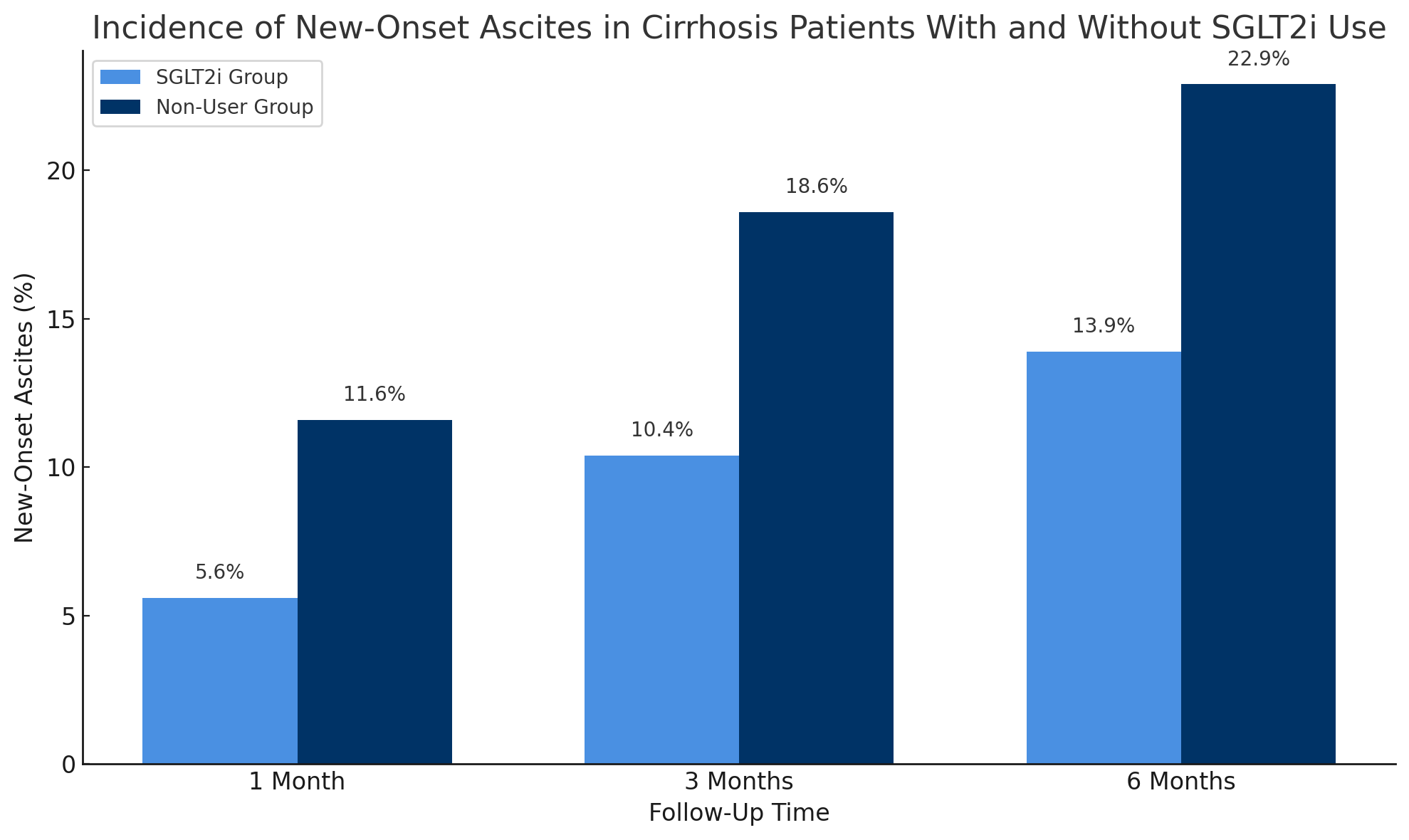Tuesday Poster Session
Category: Liver
P5767 - SGLT2 Inhibitors and the Prevention of Ascites in Cirrhosis: A Multicenter Real-World Retrospective Cohort Study
Tuesday, October 28, 2025
10:30 AM - 4:00 PM PDT
Location: Exhibit Hall

Nino Gudushauri, MD (she/her/hers)
Einstein Healthcare Network
Philadelphia, PA
Presenting Author(s)
Nino Gudushauri, MD1, Irakli Lemonjava, MD1, Liza Bagashvili, MD1, Shalva Eliava, MD2, Maria Lagarde, MD1
1Einstein Healthcare Network, Philadelphia, PA; 2Englewood Hospital and Medical Center, Englewood, NJ
Introduction: Recurrent ascites is a common and debilitating complication of cirrhosis and portal hypertension, often requiring repeated paracentesis and hospitalizations. Despite guideline-directed use of diuretics, durable pharmacologic strategies to prevent recurrence are limited. Sodium-glucose cotransporter-2 inhibitors (SGLT2i), originally approved for type 2 diabetes, exert natriuretic, anti-inflammatory, and vascular effects that may benefit patients prone to volume overload. We examined whether SGLT2i use is associated with reduced incidence of ascites in patients with cirrhosis and portal hypertension using real-world data from the TriNetX research network.
Methods: We conducted a retrospective cohort study using TriNetX, a research platform that aggregates de-identified electronic health records from multiple healthcare systems. Adults (≥18 years) with cirrhosis and portal hypertension were identified between January 1, 2013, and October 10, 2024. Patients with prior ascites were excluded. Cohorts were stratified by SGLT2i exposure. The index date was the first recorded SGLT2i prescription or a matched date in non-users to reduce immortal time bias. Propensity score matching was performed 1:1 based on demographics and >10 comorbidities, totaling 27 baseline variables. The primary outcome was new-onset ascites at 1, 3, and 6 months. Risk ratios (RR), absolute risk reductions (ARR), and number needed to treat (NNT) were calculated; p < 0.05 was considered significant.
Results: We matched 3,045 SGLT2i users to 2,635 non-users. At 1 month, ascites occurred in 5.6% vs. 11.6% (RR 0.48, ARR 6.0%, NNT 17; p < 0.0001). At 3 months, 10.4% vs. 18.6% developed ascites (RR 0.55, ARR 8.2%, NNT 13; p < 0.0001). At 6 months, rates were 13.9% vs. 22.9% (RR 0.67, ARR 9.0%, NNT 11; p < 0.0001).
Discussion: SGLT2 inhibitor use was associated with a significant and sustained reduction in the incidence of ascites across all time points. The effect may reflect improvements in portal pressure, sodium handling, and vascular function. While confounding cannot be excluded, the strength and consistency of the association support further prospective evaluation. SGLT2i may represent a promising adjunctive strategy to prevent ascites recurrence in cirrhosis.

Figure: Incidence of Ascites in Patients with Cirrhosis with and without SGLT2i use
Disclosures:
Nino Gudushauri indicated no relevant financial relationships.
Irakli Lemonjava indicated no relevant financial relationships.
Liza Bagashvili indicated no relevant financial relationships.
Shalva Eliava indicated no relevant financial relationships.
Maria Lagarde indicated no relevant financial relationships.
Nino Gudushauri, MD1, Irakli Lemonjava, MD1, Liza Bagashvili, MD1, Shalva Eliava, MD2, Maria Lagarde, MD1. P5767 - SGLT2 Inhibitors and the Prevention of Ascites in Cirrhosis: A Multicenter Real-World Retrospective Cohort Study, ACG 2025 Annual Scientific Meeting Abstracts. Phoenix, AZ: American College of Gastroenterology.
1Einstein Healthcare Network, Philadelphia, PA; 2Englewood Hospital and Medical Center, Englewood, NJ
Introduction: Recurrent ascites is a common and debilitating complication of cirrhosis and portal hypertension, often requiring repeated paracentesis and hospitalizations. Despite guideline-directed use of diuretics, durable pharmacologic strategies to prevent recurrence are limited. Sodium-glucose cotransporter-2 inhibitors (SGLT2i), originally approved for type 2 diabetes, exert natriuretic, anti-inflammatory, and vascular effects that may benefit patients prone to volume overload. We examined whether SGLT2i use is associated with reduced incidence of ascites in patients with cirrhosis and portal hypertension using real-world data from the TriNetX research network.
Methods: We conducted a retrospective cohort study using TriNetX, a research platform that aggregates de-identified electronic health records from multiple healthcare systems. Adults (≥18 years) with cirrhosis and portal hypertension were identified between January 1, 2013, and October 10, 2024. Patients with prior ascites were excluded. Cohorts were stratified by SGLT2i exposure. The index date was the first recorded SGLT2i prescription or a matched date in non-users to reduce immortal time bias. Propensity score matching was performed 1:1 based on demographics and >10 comorbidities, totaling 27 baseline variables. The primary outcome was new-onset ascites at 1, 3, and 6 months. Risk ratios (RR), absolute risk reductions (ARR), and number needed to treat (NNT) were calculated; p < 0.05 was considered significant.
Results: We matched 3,045 SGLT2i users to 2,635 non-users. At 1 month, ascites occurred in 5.6% vs. 11.6% (RR 0.48, ARR 6.0%, NNT 17; p < 0.0001). At 3 months, 10.4% vs. 18.6% developed ascites (RR 0.55, ARR 8.2%, NNT 13; p < 0.0001). At 6 months, rates were 13.9% vs. 22.9% (RR 0.67, ARR 9.0%, NNT 11; p < 0.0001).
Discussion: SGLT2 inhibitor use was associated with a significant and sustained reduction in the incidence of ascites across all time points. The effect may reflect improvements in portal pressure, sodium handling, and vascular function. While confounding cannot be excluded, the strength and consistency of the association support further prospective evaluation. SGLT2i may represent a promising adjunctive strategy to prevent ascites recurrence in cirrhosis.

Figure: Incidence of Ascites in Patients with Cirrhosis with and without SGLT2i use
Disclosures:
Nino Gudushauri indicated no relevant financial relationships.
Irakli Lemonjava indicated no relevant financial relationships.
Liza Bagashvili indicated no relevant financial relationships.
Shalva Eliava indicated no relevant financial relationships.
Maria Lagarde indicated no relevant financial relationships.
Nino Gudushauri, MD1, Irakli Lemonjava, MD1, Liza Bagashvili, MD1, Shalva Eliava, MD2, Maria Lagarde, MD1. P5767 - SGLT2 Inhibitors and the Prevention of Ascites in Cirrhosis: A Multicenter Real-World Retrospective Cohort Study, ACG 2025 Annual Scientific Meeting Abstracts. Phoenix, AZ: American College of Gastroenterology.
